|
Back to TOP

FDA Leads International Workshop on Combating Illicit Health Products
More than 100 persons from government, multilateral international organizations, industry, and civil society participated in a September 15-16 workshop in Paris on combating the trade in illicit health products.
The two-day event was co-hosted by the FDA and the Organisation for Economic Co-operation and Development (OECD) who have partnered under the auspices of the OECD’s Task Force on Countering Illicit Trade to promote a whole-of-governments approach to protect consumers from illicit products.
Over the last few years, criminal networks have become increasingly sophisticated, capable of exploiting regulatory, legal, and other gaps to ship and or transship illicit and potentially dangerous health products. These may even include drugs intended to treat serious and life-threatening conditions, such as various forms of cancer, and that require strict temperature controls to be administered safely. Many of these products are being ordered online by consumers and shipped in small packages.
“When criminals are intent on probing for potential weaknesses, there’s a risk they’ll succeed, and products will slip through,” said Mark Abdoo, associate commissioner for global policy and strategy, in opening remarks. “However, these gaps are less likely to occur if multiple countries and their arsenals of authorities that crosscut multiple sectors of government coordinate their efforts in what we call a whole-of-governments approach.”
The FDA’s Office of Criminal Investigations has been piloting that approach with the United Kingdom through a series of five initiatives called Operation Lascar. The latest initiative involved the U.S. FDA’s Office of Criminal Investigations (OCI is a component of the Office of Regulatory Affairs), U.S. Customs and Border Protection, the U.S. Patent and Trademark Office, the U.S. Embassy in London, and the United Kingdom’s HM Revenue & Customs, Border Force, and Intellectual Property Office. Taken together, these five initiatives were responsible for the initiation of more than 80 new FDA criminal investigations and the identification of more than 3,000 violative shipments of illicit medicines intended for the United States. Operation Lascar was discussed by OCI’s Kerry Mannion as a case study at the workshop.
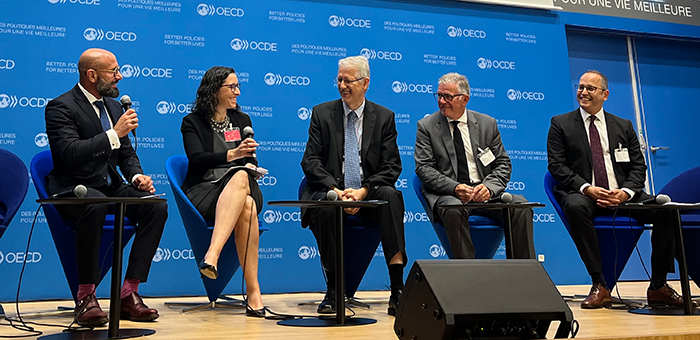
The FDA's Mark Abdoo and Andi Fristedt, at left, participate on the Executive Panel at the OECD workshop.
During the Executive Panel, the first session of the event, Andi Fristedt, FDA deputy commissioner for policy, legislation, and international affairs, discussed the importance of global cooperation to address shared threats, as demonstrated during the COVID-19 pandemic, when long-standing relationships with foreign regulatory counterparts proved essential to facilitating rapid exchanges of information and concerted approaches. “The FDA has taken an active part in many multilateral initiatives to address illicit health products,” she said. “Valuable lessons learned, and best practices can be drawn from these examples. One common theme is the need for global leadership to promote coordinated action at the international level and cross-sector collaboration.”
The topics covered in the other workshop sessions included:
- Operation Stop, organized by the World Customs Organization (WCO) with the support of a number of international organizations, which targeted illegal trafficking of COVID-19-related products such as illicit and substandard medicines, and vaccines, as well as PPE and other COVID-related medical devices such as masks, gloves, COVID-19 test kits, thermometers, and gowns. A total of 502 million pieces were seized during Operation STOP II from April 2021 to May 2022.
- Data gathering and other efforts by multilateral organizations, including Interpol, Europol, the World Health Organization, the World Trade Organization, the MEDICRIME Committee of the Council of Europe, and the International Narcotics Control Board, in addition to the WCO.
- How to foster international, bilateral, and plurilateral collaboration (greater use of confidentiality commitments, data sharing, communications).
- The potentially positive role that could be played by intermediaries such as online stores, social media platforms, internet providers, and the application of varying postal policies of nations around the world.
- Building partnerships with the private sector, including pharmaceutical companies, which may possess actionable information.
What caught everyone’s attention was the scale, magnitude, and underlying causes of transshipments — when illicit products enter the U.S. marketplace after first being shipped to a country in the European Union as an intermediate destination, usually without entering customs — a practice that has increased during the COVID-19 pandemic.
A review of recent FDA data suggests a worrisome uptick in detentions from certain European Union member states and a relationship between bad actors transshipping products to the United States from more than one European country, said Catherine Hermsen, FDA assistant commissioner for criminal investigations, during the session on this topic. Recently, the FDA examined 100 mail detentions appearing to originate from an EU member state, which were found to contain 40 different products, intended for five countries, and that were associated with 33 online pharmacies. Every shipment was associated with the same return address in this EU member state, she said. One issue identified in the session: the potential regulatory gap of the world's 3,500 (according to 2019 OECD data) free-trade zones, which offer lighter regulations and controls and are therefore vulnerable to abuse by illicit traders. The OECD has made progress toward a certification scheme for these zones that could help address this issue.
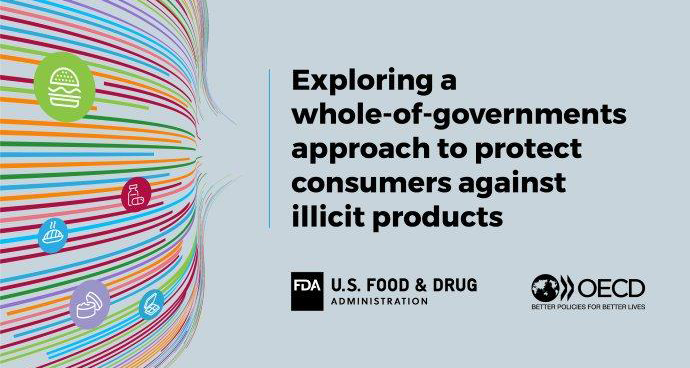
After two days, it was clear that much is already going on in this sector, however what is needed is greater communication, coordination, and cooperation toward a strategic multisectoral effort, according to Ritu Nalubola, director of the FDA’s Europe Office. From information-sharing mechanisms and interoperable data platforms for effective real-time communication to coordination of capacity-building efforts and regulatory cooperation, the experts at the workshop provided substantive insights for the FDA to consider next steps in building on the momentum gained thus far. A mapping of activities and key stakeholders to get a better understanding of who is doing what to address this globally shared problem was of interest to many.
Just hearing what others are doing is a good start, participants said.
Assistant FDA Commissioner Hermsen stressed the expandability of partnerships and the importance of obtaining and maintaining executive level buy-in when approaching multisectorial work. “Further, even in your own sector, the most critical component of effective engagement is identifying what is important for each stakeholder involved.”
Greater focus on the patient is also needed, according to OCI’s Mannion. “We’ve lost the debate over price,” he said. “We need to focus on the health and safety aspect, capturing the real-world stories [affecting patients] so that consumers will think twice before buying products on the internet.”
Next steps are still under discussion. Participants are likely to establish a core group of experts to address identified issues.
Whatever approach emerges from the workshop “should translate into a path toward prevention rather than response,” said OGPS’ Abdoo. That means, he said, not only getting to the source on supply but addressing the demand for these products.
“The fact is — the stakes are high,” he said. “Illicit trade is a severe threat that not only damages economic growth but also undermines national security, good governance, the rule of law, and trust in government. And for the FDA and our regulatory counterparts, illicit goods that enter our marketplaces can pose serious health and safety consequences, including death.”

John Skerritt, head of Australia’s Therapeutic Goods Administration (TGA), visited the FDA’s White Oak Campus September 19-20 for a series of conversations with his FDA counterparts, including a commissioner’s meeting with Principal Deputy Commissioner Janet Woodcock, M.D., Deputy Commissioner for Policy, Legislation, and International Affairs Andi Fristedt, and Chief of Staff Julia Tierney, in addition to FDA Commissioner Robert M. Califf, M.D.
|
Since the TGA oversees human medical products as well as nicotine and vaping products, separate sessions were arranged with the senior leadership from the Centers for biologics, devices, drugs, and tobacco. Skerritt also met separately with the leadership of the Office of Women’s Health and with the leadership of the Oncology Center for Excellence.
To mark the visit, the Office of Global Policy and Strategy published an interview with Professor Skerritt, “Australia’s Robust Strategy for Regional and Global Medical Product Engagement,” under the OGPS series called From a Global Perspective.
“We’ve found that close interactions with each of the center directors and senior staff has been tremendously valuable during COVID and will continue to be in the future,” he said in the interview.
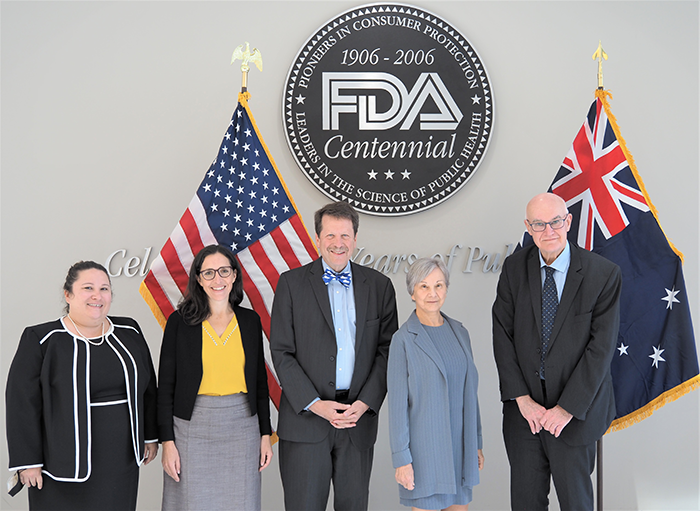
(Left to right) Julia Tierney, Andi Fristedt, Dr. Robert Califf, Dr. Janet Woodcock, and John Skerritt.
FDA Signs Confidentiality Commitment with Ecuadorean Seafoods Agency
On August 18, the Food and Drug Administration signed a confidentiality commitment (CC) with Ecuador’s Vice Ministry of Aquaculture and Fisheries (VMAF) in Guayaquil, Ecuador.
Associate Commissioner for Global Policy and Strategy Mark Abdoo signed the CC on behalf of the FDA. Andrés Arens Hidalgo, Ecuador’s Vice Minister of Aquaculture and Fisheries, signed the CC on behalf of the VMAF.
The CC will allow for the exchange of confidential information, including inspection records, draft rulemaking and guidance, and other nonpublic documents. It is an important step in preparing Ecuador for participation in a three-country pilot program designed to ensure the safety of shrimp imported to the United States.
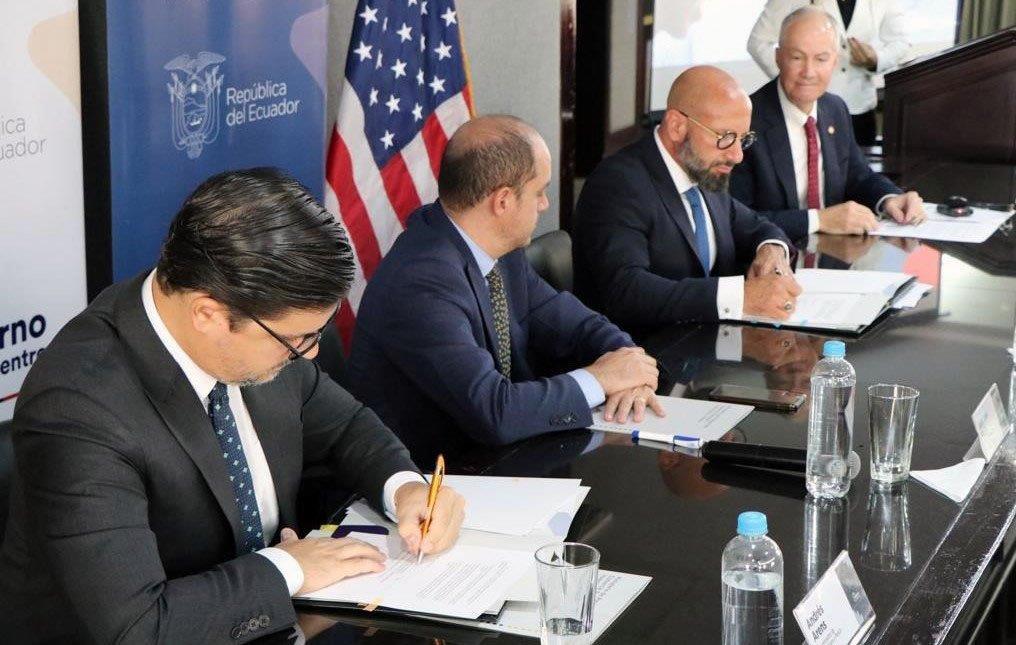
In 2021, Congress provided $6 million to develop and implement options for regulating shrimp imports, including imports from the three largest exporting countries by volume over the last three calendar years. Currently, these countries are India, Ecuador, and Indonesia.
The FDA is preparing to evaluate the effectiveness of using a new form of arrangement — a Regulatory Partnership — in these countries. The partnership aims to leverage commodity-specific oversight systems — in this case, involving shrimp — along with data and information, to strengthen food safety before and at the port of entry.
“The FDA recognizes the importance of establishing strong partnerships with all stakeholders along the farm-to-table continuum, including foreign governments, given the importance of foreign sourcing in U.S. food consumption,” said Don Prater, the FDA’s Associate Commissioner for Imported Food Safety, before the CC signing. “The principal goal of the Regulatory Partnership will be to establish a forum with Ecuador where we can learn about our respective regulatory authorities and how we can work together to effectively strengthen the enforcement of food safety measures around shrimp.”
Although Ecuador is a small country, it is an important supplier of food to the United States, with $3.2 billion in exports in 2021. Half of that amount was seafood, including shrimp, tuna, mahi mahi, and swordfish. In addition, Ecuador supplies the United States with bananas, plantains, mangoes, vegetables like broccoli, and cocoa and coffee products.
“The FDA’s signing of a confidentiality commitment with Ecuador’s Vice Ministry of Aquaculture and Fisheries demonstrates the importance of our partnership and the trust we place in the Vice Ministry, and it will surely lead to food safety benefits for consumers in both countries,” said Abdoo. “In short, it will allow us to take our ongoing relationship to a higher level, consulting in a frank and transparent way to achieve important food safety goals for shrimp imported into the United States,” he said.
India Office Learns about Shrimp Farming
Forty percent of shrimp consumed in the United States are from India, making it important to ensure government officials, farmers, shrimp processors, and academia understand principles of seafood safety on the farm. Toward that end, FDA India Office (INO) personnel — including Director Dr. Sarah McMullen, Deputy Director Dr. Natalie Mickelsen, and Food Safety Coordinator Dr. Pankaja Panda, along with International Policy Analyst CDR Nicole Conklin, from the FDA’s OGPS/Office of Global Operations — attended the Good Aquaculture Practices Training for farm-raised shrimp, hosted this summer by the government of India’s (GOI) Marine Products Export Development Authority (MPEDA) at their headquarters in Kochi, in the state of Kerala. The course was presented by the Joint Institute for Food Safety and Applied Nutrition (JIFSAN), an FDA-supported international training partner that is organized under the University of Maryland.
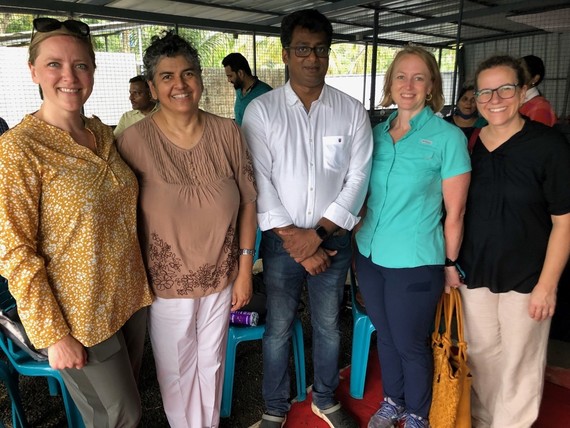
FDA Staff visit a modern shrimp farm located in the state of Kerala, India. From left to right: Nicki Conklin, Pankaja Panda, farm owner Anish George, Sarah McMullen, and Natalie Mickelsen.
Why the interest in learning best practices for raising shrimp? Because growing practices significantly impact the safety of aquacultured seafood products. In India, MPEDA works alongside other central government authorities including: the Coastal Aquaculture Administration, Export Inspections Council, and Indian state-level fisheries departments to ensure the safety and quality of India’s aquacultured shrimp. FDA inspections of aquacultured shrimp products begin with the primary processor who is responsible for assuring control of food safety hazards on the farms. The agency’s investments in partnership with the GOI will provide greater oversight on the farms and will enhance the safety of shrimp exported to the U.S. consumer.
In response to provisions outlined in the U.S. Consolidated Appropriations Act 2021, the FDA is exploring a first-of-its-kind partnership agreement with the GOI regulatory authorities to further ensure shrimp safety. The FDA and MPEDA recently signed a confidentiality commitment that facilitates the ability to share nonpublic information between these agencies. The FDA and MPEDA are also working together on assessments, joint training, and conferences to ensure safer shrimp products for consumers in India and the United States.
To enhance their understanding about aquaculture safety, the training participants visited a shrimp farm in nearby Alappuzha, Kerala. The farm’s owner, who was in the information technology industry before taking up aquaculture, has converted a few village ponds into what is now a modern shrimp farm.
The INO participants learned that for any farm, the two most important food safety considerations are the feed and water quality:
-
Feed is the most expensive component of shrimp farming and can take up to 60% of operating costs per harvest cycle. Fish meal and soybean-based feeds are the most commonly used and need to be sourced from reliable suppliers, as any contamination with pesticides, other chemicals, or veterinary drugs, puts the shrimp at risk of containing unsafe post-harvest residues. Proper supply controls, storage, and testing of feed are critical to ensure safe shrimp.
-
Water is just as important as feed. Shrimp sourced from contaminated water can lead to pathogens in the final food product, so a clean water source is important. Also, shrimp need dissolved oxygen in the water to breathe, and more dissolved oxygen is needed as they grow. Oxygenation of water in ponds is done by aerator paddles at timed intervals during the day. Dissolved oxygen levels are frequently tested by farm employees. Records for all water and feed testing are required and need to be maintained for inspections by state and central government agencies.
Biosecurity of farms is also vital if the farmer is to avoid contamination of the shrimp ponds by animals, people, or equipment. In fact, biosecurity addresses anything that comes from outside the farm. One of the ways to protect the shrimp from disease spread and wild animal predation is the placement of nets over the top of ponds to prevent birds from entering, and nets along the pond edges to prevent entrance of crabs, both of which can bring outside diseases to the farm. Another common practice is for workers and visitors to wash their hands in a sanitizing solution and rinse their footwear in a sanitizing footbath before entering the pond area. These practices prevent diseases — sometimes deadly — from entering the ponds and infecting the shrimp, resulting in huge losses to the farmer. If diseased shrimp are detected at a global port of entry, the shipment may be refused by the importing country, leading to the required destruction of the shrimp or having the shipment sent back to India.
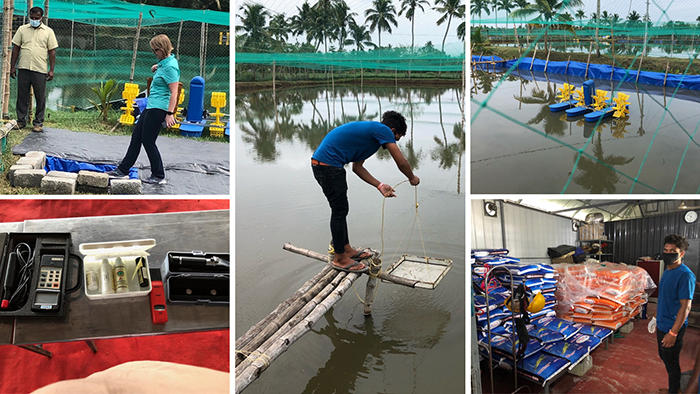
The workings of a shrimp farm. Upper Left: INO’s Sarah McMullen sanitizes her footwear in a chlorinated foot dip to prevent tracking disease vectors to the pond area. Note behind her the netting above and surrounding the pond used to stop wildlife from getting into the pond. Center: Farm worker checks shrimp for size and health. Upper right: Aeration paddles are used to increase oxygenation in the ponds. Lower right: Storage of bags of soybean meal and fish meal, for feed. Lower left: Test kit for chlorine content of foot dip and oxygen content of pond water.
This glimpse into the operations and challenges facing India’s 77,000+ shrimp farms will help expand agency insight regarding the challenges that face shrimp farmers and why it is important for the FDA to collaborate with the GOI to ensure the safety of imported shrimp.
India Office Supports Seafood Import Training
The FDA India Office and India’s Export Inspection Council (EIC) co-hosted a series of FDA Import Trainings during late August, which were held in four cities across India: Delhi, Mumbai, Kolkata, and Chennai. The FDA India Office has a long-standing relationship with the EIC, strengthened by a confidentiality commitment signed in 2016 by both agencies. Historically, the FDA and EIC have also partnered to provide training to the Indian seafood industry on a variety of topics including seafood safety, seafood HACCP (Hazard Analysis and Critical Control Points), and preventive controls.
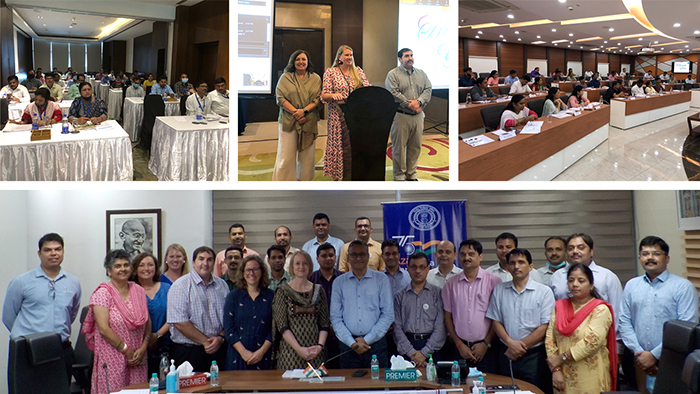
Views of India Office personnel, FDA/ORA instructors, and the many students attending import trainings held in cities across India.
Last month’s training was targeted at seafood exporters and Government of India regulators and featured three instructors from the FDA’s Office of Regulatory Affairs — Consumer Safety Officers Cindy Ford and Anna Brannen, and Program Analyst Owais Tomhe. India Office staff — Director Dr. Sarah McMullen, Deputy Director Dr. Natalie Mickelsen, and Food Safety Coordinator Dr. Pankaja Panda — took turns providing the opening remarks.
Over 300 attendees — both in person and remote — received critical information on the FDA’s import program and how to ensure that their products are compliant with FDA regulations when offered for import to the United States. Participants also learned where to find additional information and guidance.
The India Office receives multiple inquiries each week regarding the intricacies of the FDA import process and were instrumental in suggesting that the FDA develop a video on the process. Additional import topics are currently under development by staff at ORA and OGPS.
Tangible Progress Reported at Second Annual Food Safety Partnership Meeting
The FDA and its regulatory counterparts in Mexico — the Federal Commission for the Protection against Sanitary Risks (COFEPRIS) and the National Service of Agro-Alimentary Health, Safety, and Quality (SENASICA) — reported progress in advancing food safety in both countries during the second annual meeting of their Food Safety Partnership (FSP) on August 25 in Mexico City.
The three regulators established the FSP in August 2020, expanding the scope of their previous 6-year-old produce safety partnership to include the safety of all human food. During this year’s meeting, the agencies reported tangible progress involving the FSP’s workgroups and discussed plans for the coming year.
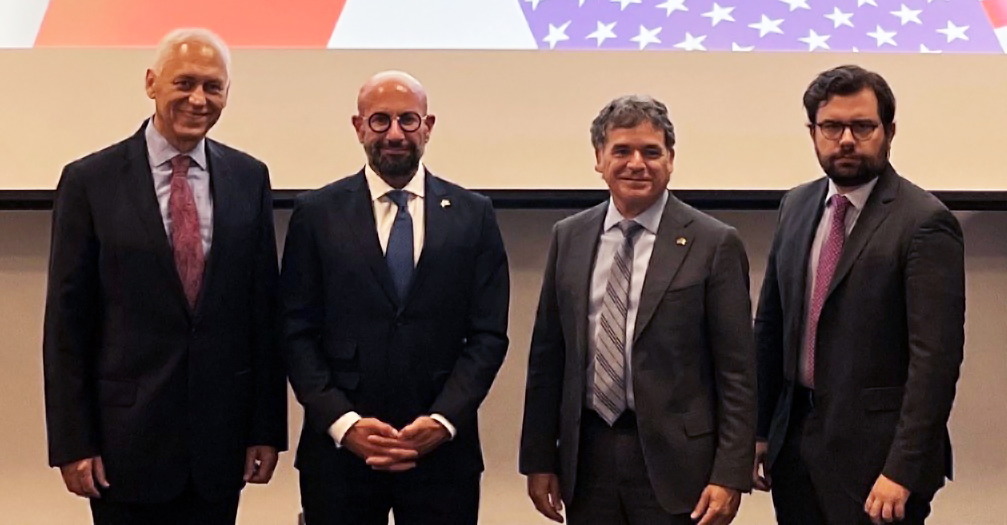
(Left to right) Francisco Javier Trujillo Arriaga, director in chief of SENASICA; Mark Abdoo, FDA’s associate commissioner for global policy and strategy; Frank Yiannas, FDA’s deputy commissioner for food policy and response; and Alejandro Svarch Pérez, federal commissioner for COFEPRIS.
“We are building on the long-standing partnership for the U.S. and Mexico to work together to contain outbreaks of foodborne illness and lessen consumer exposure to foodborne hazards. As we approach the 200th anniversary of U.S.-Mexico relations, keeping this partnership strong is more important than ever,” Frank Yiannas, the FDA’s deputy commissioner for food policy and response said in a same-day press release issued by the FDA.
Reported progress and outcomes included:
-
Work Group One – Strategic Priorities (addressing commodity-specific issues): Exchanged key information and plans that guided efforts to address a 2021 Salmonella outbreak linked to bulb onions from the State of Chihuahua, Mexico. The three agencies collaborated to share information on their respective onion plans to guide response and prevention efforts such as: SENASICA’s mobile laboratory for assessing field samples from inspections; the FDA’s Foreign Supplier Verification inspections for onion importers; and technical meetings hosted with Mexican onion growers and packers to learn more about their production practices. The FDA and SENASICA also collaborated with the papaya industry on the verification of the papaya checklist, a tool to further encourage the adoption of food safety best practices for papaya.
-
Work Group Two – Laboratory Collaboration: Discussed progress on the implementation by SENASICA and COFEPRIS of the FDA’s Cyclospora methodology distance training plan, which is based on the Bacteriological Analytical Manual, or BAM, Chapter 19b method for detecting Cyclospora cayetanensis in produce samples. Competency in the methodology will expand international capacity for detecting this pathogen. SENASICA also committed to a data-sharing agreement with the FDA to upload 100 genomic sequence data sets (food and environmental) to the GenomeTrakr network. This is an important contribution to the GenomeTrakr network and will allow both Mexico and the United States to identify and respond to outbreaks faster and with more precision, helping to minimize the number of consumers impacted.
-
Work Group Three – Enhancing Outbreak Response: Established a revised Binational Outbreak Notification Protocol to improve timely and effective communication by sharing genomic sequence data (including a reference to the laboratory methodology for its detection) and using the FDA CORE Investigation Table to share publicly available epidemiologic information. The table was introduced in 2020 to share information on the FDA’s investigations of foodborne illness outbreaks, even in their early stages, and as soon as the FDA begins its response to an outbreak. As a next step, the FDA, SENASICA, and COFEPRIS are working together on a new model for conducting inspections that would involve the participation of all three regulatory agencies where a food safety issue is suspected.
-
Work Group Four – Food Safety Training: During this year’s meeting, the FDA, SENASICA, and COFEPRIS reviewed Produce Safety Rule (PSR) trainings they had facilitated, including those with cilantro growers in Puebla, avocado growers in Jalisco, and bulb onion growers in Chihuahua. The three agencies also worked with EMEX, a mango association, to conduct three PSR trainings for mango producers in the states of Sinaloa, Nayarit, and Jalisco. The FDA also provided outreach to SENASICA and COFEPRIS personnel about the FDA’s proposed rule for agricultural water: “Standards for the Growing, Harvesting, Packing, and Holding of Produce for Human Consumption Relating to Agricultural Water.”
Mexico is a primary supplier of fresh fruits and vegetables to the United States. FDA data shows that about one-third of all agency-regulated human food imported into the United States is from Mexico, including 60% of our fresh produce imports.
“Within the framework of the celebration of 200 years of diplomatic relations between Mexico and the United States, we are honored to be FDA partners,” Francisco Javier Trujillo Arriaga, director in chief of SENSASICA was quoted as saying in the FDA’s press release. “We know the importance of what is at stake, and we are convinced that the success stories we have had with producers and marketers of different types will generalize to other environments.”
“In this annual meeting, various activities were carried out that have contributed to a better understanding of the safety systems of both countries,” said Federal Commissioner for COFEPRIS, Alejandro Svarch Pérez in the same press release. “In addition, they highlighted that they have allowed for a greater rapprochement between the main actors in the food production chain, with the aim of coordinating efforts and taking advantage of the experience and knowledge available.”
Besides the partnership meeting, officials from the FDA, SENASICA, and COFEPRIS toured a tomato greenhouse to observe Mexico’s growing and harvesting practices. They also met with Mexican produce associations to hear about their advanced food safety measures — including traceability protocols, produce safety training, and commodity-specific guides — and the challenges they currently face.
Other FDA participants, besides Yiannas, included: Don Prater, the FDA’s associate commissioner for imported food safety; Mark Abdoo, the FDA’s associate commissioner for global policy and strategy; Mike Rogers, assistant commissioner for human and animal food operations in the Office of Regulatory Affairs; Doug Stearn, deputy director for regulatory affairs in the FDA’s Center for Food Safety and Applied Nutrition; and Katie Serrano, director of the FDA’s Latin America Office.
Imported Foods: FDA’s Pesticide Residue Monitoring Report
The enticing array of fruits, vegetables, grain products, and other food items on display at your local grocer are the end result of a managed process from farm to retailer. As part of the process, growers, both in the United States and abroad, often use pesticides to protect their crops and products from insects, weeds, fungi, and other pests.
The Food and Drug Administration works with the Environmental Protection Agency (EPA) to ensure that food treated with a pesticide is safe to eat. The EPA sets limits called “tolerances,” which are based on safety standards, for any residues that remain in or on food; and the FDA monitors for the presence of such residues. (The U.S. Department of Agriculture, or USDA, is responsible for monitoring pesticides in meat, poultry, catfish, and certain egg products — those foods that are under USDA’s jurisdiction.)
The FDA employs a threefold strategy to enforce the EPA’s tolerances for pesticide chemical residues in human and animal food. The FDA’s pesticide residue monitoring program selectively tests for the presence of nearly 800 pesticide residues and selected industrial compounds in a broad range of imported and domestic human and animal food. For specific commodities or selected pesticide chemical residues of special interest, the FDA may also carry out focused sampling surveys. In addition, the FDA monitors the levels of pesticide chemical residues in foods prepared for consumption in its Total Diet Study, an ongoing program that monitors contaminants and nutrients in the average U.S. diet.
The FDA has been issuing annual reports of its pesticide residue monitoring program since 1987. Its latest report, for fiscal year 2020, summarizes results from testing during the onset of the COVID-19 pandemic. (We've included some interesting tables and graphs from the report, in this article.)
From October 1, 2019, through September 30, 2020, the FDA tested 2,078 human food samples (316 domestic and 1,762 import samples). Agency staff collected domestic human food samples from 35 states and imported human food samples from 79 countries/economies. The findings show that the pesticide residues in most foods are in compliance with the EPA’s pesticide tolerances. (A tolerance is the EPA established maximum residue level of a specific pesticide chemical that is permitted in or on a specific human or animal food in the United States. Anything above that level and it’s an “over-tolerance” violation.)

The FDA found that 96.8% of the samples of domestic human food and 88.4% of samples collected from imported human food were compliant with the pesticide tolerances set by the EPA. No pesticide residues were found in 40.8% of the domestic samples and 48.4% of the import samples. In the human food commodity groups, the violation rate in each group was higher for import samples. The higher violation rate affirms the validity of the sampling design in targeting import commodities more likely to contain violative pesticide residues.
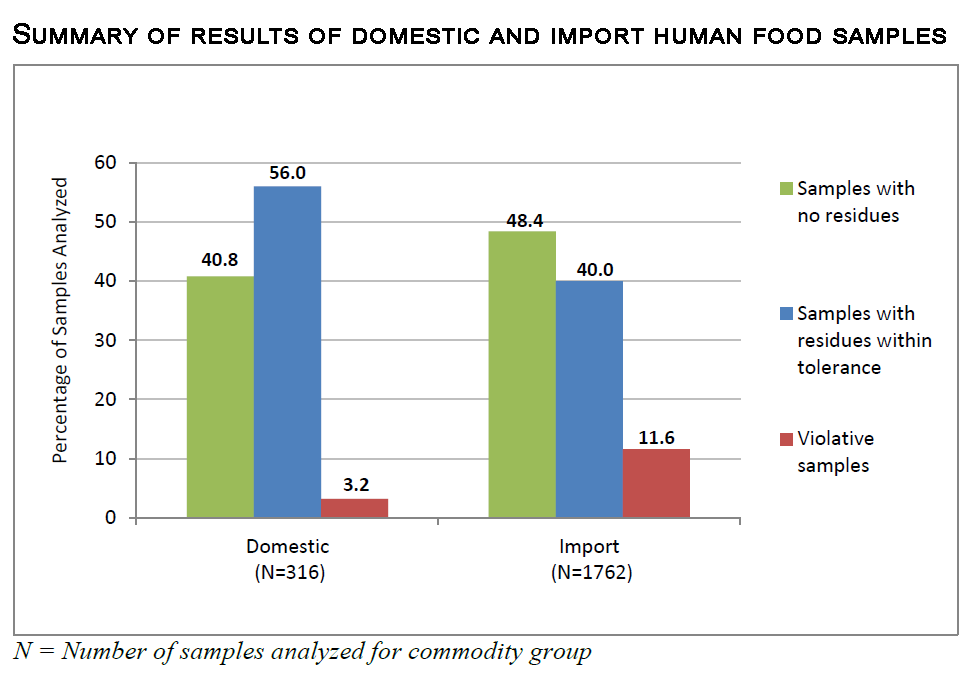 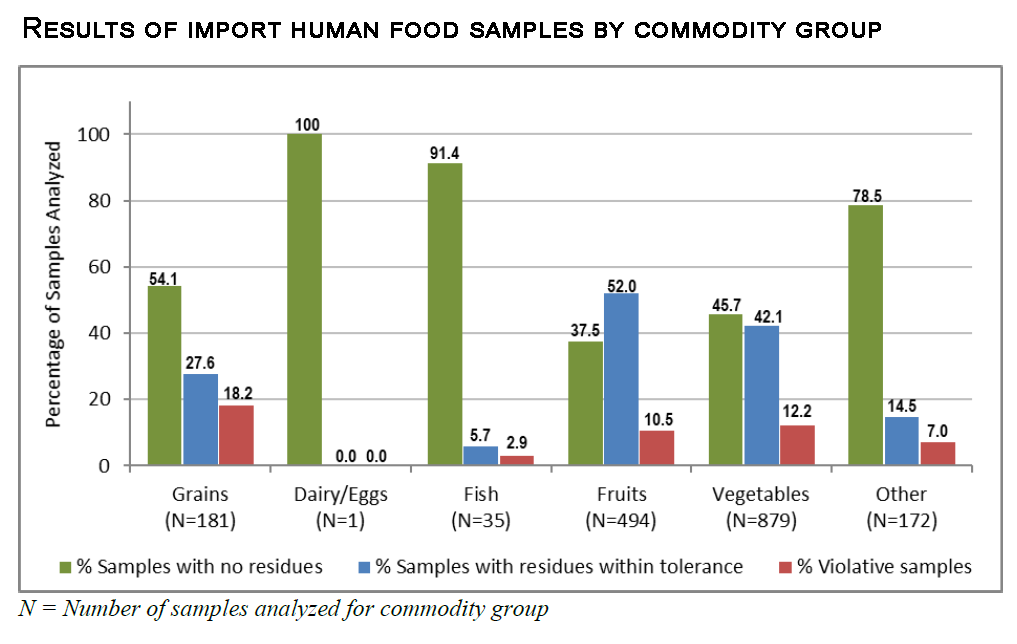
Of the 205 violative import samples, 182 had no-tolerance violations* and 53 had over-tolerance violations; 30 samples had both no-tolerance and over-tolerance violations for different pesticides contained in the same sample. Across both domestic and import samples of human foods, 185 different pesticides were detected. The top 15 most detected pesticides are listed in the following table:

The FDA also analyzed 102 animal food samples — 40 domestic and 62 import — for pesticides. The agency found that for animal food 100% of the domestic samples and 96.8% of import samples were compliant with federal standards. No pesticide residues were found in 30.0% of the domestic samples and 48.4% of the import samples.
The FDA’s sample collection and analysis for the FY 2020 report was impacted by the pandemic. Approximately 50% fewer human food samples and 70% fewer animal food samples were collected in FY 2020 compared to FY 2019. And more import samples were collected in FY 2020 relative to domestic samples than in previous years; however, in future years, the agency expects to return to its pattern prior to the pandemic years. Nevertheless, the results from samples collected and analyzed in FY 2020 demonstrated a rate of compliance similar to what had been shown in previous years.
The FDA pesticide program is designed to focus on products that have a history of violations or are suspected of violations, based on information such as reports from other agencies and pesticide usage data. Historically, the violation rate for imported foods is higher than for domestic foods; and FY2020 continues that trend. The violation rate for imported foods (11.6%) was over three times higher than the rate for domestic foods (3.2%). The majority of the violations for imported commodities are no-tolerance violations, with approximately 78% of the violative residues less than 0.1 parts per million.
Examination of the FY 2020 pesticide data from the analysis of imported human foods indicates that the commodities listed in the below table may warrant increased sampling of import products in the future.
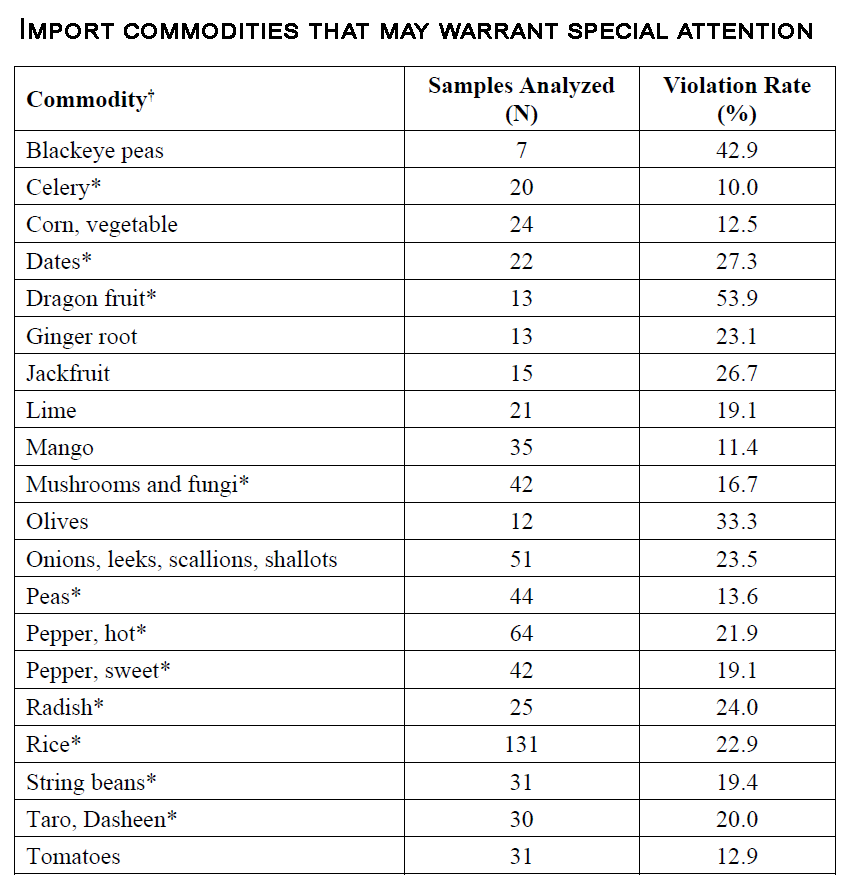
These specific commodities were selected if they had a 10% violation rate or higher, and with either at least 20 samples analyzed or a minimum of three violations. *Commodity was also on the FY 2019 table of import commodities warranting special attention. ǂData listed for commodities in this table are based upon specific product definitions and may not be directly comparable to product summary subcategories listed in Appendix C of the FY2020 Report.
ENDNOTE: *By “no-tolerance” violations, we refer to circumstances where a given commodity doesn’t have an EPA-assigned tolerance for a specific pesticide chemical or an exemption from the need for such a tolerance. All the EPA tolerances for various commodities are described in 40 Code of Federal Regulations (CFR) Part 180.]
|